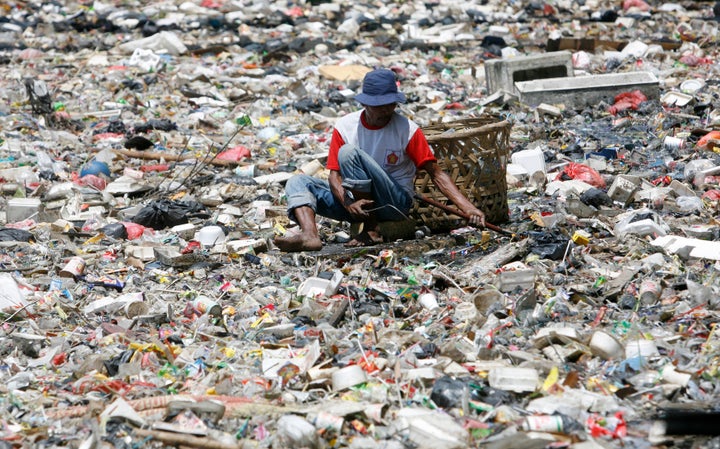
Plastic pollution has become so ubiquitous it may serve as evidence that humanity has launched the planet into a new geological epoch.
For nearly two decades, scientists have suggested that the world entered the Anthropocene, an epoch defined by human meddling, sometime in the 20th century. A group of scientists at the International Geological Congress in Cape Town, South Africa, on Monday formally proposed recognizing the period that began around 1950 as a new epoch.
The move underscores the extent to which humans as a species have already polluted the natural world, and the pace at which it continues to worsen.
“Being able to pinpoint an interval of time is saying something about how we have had an incredible impact on the environment of our planet,” Colin Waters, principal geologist at the British Geological Survey and secretary of the Working Group on the Anthropocene, told The Guardian, which published a meaty report on the geologists’ argument. “The concept of the Anthropocene manages to pull all these ideas of environmental change together.”
Nuclear bomb tests, which began in 1945, may serve as the clearest marker of the beginning of the Anthropocene. The end of Late Cretaceous Period about 66 million years ago is marked in the Earth’s rock layers by a spike in metal iridium, dispersed by the meteorite scientists believe collided with the planet and wiped out dinosaurs. Radioactive material spread by atomic explosions could serve as a similar benchmark for the new epoch.
Over the next three years, the Working Group on the Anthropocene plans to study layers of rock to determine when the present Holocene Epoch ended, and whether enough radioactive material, plastics and other signs of humanity have accumulated to mark the beginning of the Anthropocene.
The 66 years since 1950 are a mere blip in the geological timetable, meaning such evidence may still be relatively scarce. The rapid acceleration of humanity’s impact on the planet, however, makes it worth examining.
Epochs are also marked by the fossils left behind by the creatures that lived in those time periods. For example, skeletal outlines of long-dead Tyrannosaurus rex in rock serve as hallmarks of the Late Cretaceous Period, when the carnivorous reptiles roamed the planet.
When future geologists study the Anthropocene, fossilized plastic garbage and domestic chickens may be key signs of an epoch defined by the humans who lived at that time.
Plastics, produced mostly by burning oil, first became widespread in the 1940s. Now, naturally forming rocks cobbled together from plastic, sand, pebbles and coral have begun washing up on beaches in Hawaii. And, at the current pace, the oceans will contain more plastic than fish by 2050, according to a January report from the World Economic Forum and the Ellen MacArthur Foundation. A plastic water bottle, for example, takes roughly 450 years to disintegrate.
The industrialized farming of chickens has dramatically increased since 1950. The amount of chicken meat available in the U.S. increased by more than 2,838 percent since then, according to data from the National Chicken Council, a trade association. More than 50 billion chickens are slaughtered in the world each year, according to United Poultry Concerns, a nonprofit animal rights group. It’s unclear how that stacks up with the total annual population of Tyrannosauri reges ― yes, that’s the plural of T. rex ― but the factory-like churn of birds is almost certainly higher than the natural populations of many large creatures throughout history. And the methane gas produced from chicken manure contributes heavily to the greenhouse gas emissions causing the planet to warm.
The 180-country climate accord reached in Paris in December is the first time all the world’s major powers agreed to try to curb rising global temperatures before the end of the century. Without radical cuts in carbon emissions, the world could warm beyond 2 degrees Celsius, or 3.6 degrees Fahrenheit, at which point scientists say cataclysmic changes would happen to the environment.
It may be too late to erase humans’ imprint on the planet, but there may still be time to combat some of their worst effects on the climate.
